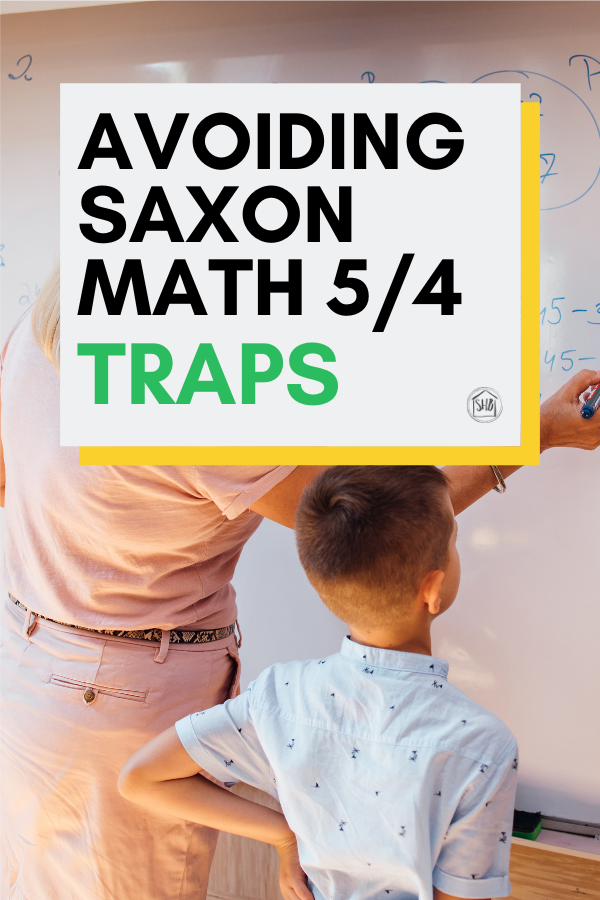
We embarked on our first year of “independent math” using Saxon 5/4 this year. My fourth grader and I learned a lot this year – much of it completely unrelated to math. As we trudged along in our year, I took note of the simple lessons we were learning along the way. I knew new students and teachers would want a follow-up to the prep I did at the beginning of the year.
This post may include affiliate links. If you click and make a purchase based on my recommendation, I get a small remuneration at no extra expense to you. I only recommend things I use and believe to be a blessing.
Here are the simple lessons we learned together in Saxon Math 5/4. This article ended up being a lot longer than I expected, so I broke it up into different segments. And I created a Table of Contents for your ease of reading.
First up the lesson of Dialogue.
Dialogue
If you subscribe to the idea of Dorothy Sayer’s stages of learning, our Saxon 5/4 students are on the cusp of the next stage of learning – the dialectic. This is the stage where all the questions start coming. They tell me it looks like questioning authority – questioning the “why” and “wherefore” of things. The foundation of simple truths has been laid in the previous stage of learning. Thus our Saxon 5/4 students are putting in the final stones of their foundation while looking ahead to some of the next steps of their education.
Into this stew of development, Saxon Math 5/4 is tossed. My initial thoughts on the purpose of Saxon Math 5/4 have proved accurate. This year is meant to teach a new skill to developing students: the ability to take instruction from a textbook. Thus, the dialogue going on at this stage of learning and stage of Saxon Math is primarily with a book.
This transition can be a bit bumpy.
Early in the year, my student would happily do her work. But every day she left the problem solving portion of the warm-up blank. When we went to grade her work, she would say, “I would like some help with this.”
Gladly and excitedly, I would snap on my math teacher hat and go to the white board in our school room. Most of the time I would quickly discover she didn’t need help. She needed a sounding board. She needed to talk through the problem. A dialogue.
The transition from spoken, teacher led discussions from Saxon 1-3 into reading and writing lessons in Saxon 5/4 required a little bit of my input to “grease the wheels.”
Saxon 5/4 Trap #1
Here’s the first trap we discovered: “Mama cannot download her brain into yours.” Instead of helping my student to become more independent, problem solving (early on) became “I don’t want to think for myself” time. As I said, she would glance at the problem solving, but leave it blank, waiting for an illuminating discussion later.
At first, I was happy to help her! We made some really cool math discoveries along the way. But when I started to recognize these math “problems” were just the refusal to try, to think, I knew she was ready for a talking to.
We went back over the math problem solving strategies she has in her toolbelt. I encouraged her to think through the problem, draw a picture, make a list of what she knows, something to get those brain synapses going. All this needed to be done before asking for help.
After our talk about problem solving techniques, she rarely had questions after lesson 40 or so. Her independence blossomed. I even heard her talking to her textbook (or herself).
Saxon Math 5/4 Trap #2
Get ready. I am about to express an unpopular opinion.
Outside teaching help is a Saxon Math trap! Don’t go there!
There are a lot of outside helps for those of us who are less than stellar math stars. Math teachers who go through the lessons with the student in a video format.
While I haven’t had a conversation with John Saxon on the matter, I have listened to him speak at length about his math curriculum. And I have experience teaching Saxon for all of 5 years. Thus, you are welcome to take this advice for what it is worth, with a grain of salt, or however you prefer.
The reason for my opinion on this matter is the lack of dialogue in this method of math help. The outside teacher cannot look into the face of the Saxon Math student and determine when she “gets it.” She cannot know the trouble spots for the student or understand the student’s strengths in math or otherwise.
As I said at the beginning of this discussion, Saxon Math 5/4 is the beginning of a dialogue about math. The dialogue is to take place primarily now between the student and the textbook. A willing sounding board is helpful in the beginning. But an outside math teacher is not a sounding board. It is one-way instruction. The teacher cannot even rephrase the words if the student is just not getting it. If the student doesn’t get it even after the explanation from the outside teacher, where else will she turn?
Avoiding Saxon Math 5/4 Traps #1 & 2
As I said, we learned through our year to dialogue with one another and with a book about math. Thus, in the very rare instances post-lesson 40 where my student needed help, I precede with caution. I use all my teacher-y skills to do the following:
- Ask her to read the problem.
- Only ask questions.
- Write only what she says down on the board.
I am convinced there is magic in speaking and reading aloud for kids. Sometimes their brains catch on to something they missed while reading silently.
Once the problem is restated, challenge yourself to ask the student only questions. psst…this is a sneaky way to know almost nothing about a subject and still teach it.
Questions look like: “What do you know?” “What are they asking for?” “Will a drawing help?” “What will the answer look like?” “How do you solve this kind of problem?” “What kind of math operation do you need to perform?” All these leading questions will help your student to use what she knows to discover what she doesn’t.
The last tip there – write only what the student says on the board – this is psychological. The above will produce answers. When you only write what the student has expressly stated, you are validating her thoughts, her ideas. And slowly she will begin to recognize her brain is powering this whole operation. She knows how to do these kinds of problems! It is beautiful!
This article got rather long. So I decided to break it up a bit. Look for the next two articles about the lessons we learned in Saxon Math 5/4 – diligence and duty.

Interested in more about Saxon Math? I hope these articles are a blessing to you:














